
The men's artistic individual all-around was an artistic gymnastics event held as part of the Gymnastics at the 1912 Summer Olympics programme. The competition was held on 12 July at the Stockholm Olympic Stadium. It was the fourth appearance of the event. There were 44 competitors from 9 nations. Each nation was limited to 6 gymnasts. The event was won by Alberto Braglia of Italy, the first man to successfully defend a title in the artistic individual all-around. The bronze medalist from 1908, Louis Ségura, this time took silver. Braglia and Ségura were the first two men to win multiple medals in the event. Italian Adolfo Tunesi earned bronze.

The men's parallel bars competition was one of eight events for male competitors of the artistic gymnastics discipline contested in the gymnastics at the 2004 Summer Olympics in Athens. The qualification and final rounds took place on August 14 and August 23 at the Olympic Indoor Hall. There were 81 competitors from 31 nations, with nations competing in the team event having up to 5 gymnasts and other nations having up to 2 gymnasts. The event was won by Valeriy Honcharov of Ukraine, the nation's second victory in the parallel bars. Hiroyuki Tomita took silver, putting Japan above the Soviet Union on the all-time medal table for the event. Li Xiaopeng of China became the seventh man to win multiple parallel bars medals with his bronze adding to his 2000 gold.

The men's parallel bars competition at the 2008 Summer Olympics was held on August 9 and 19 at the Beijing National Indoor Stadium. The eight competitors with the highest scores in qualifying proceeded to the men's parallel bars finals. There, each gymnast performed again; the scores from the final round determined the final ranking. There were 75 competitors from 27 nations that competed on the parallel bars, with nations in the team event entering up to 5 gymnasts while other nations could enter up to 2. The event was won by Li Xiaopeng of China, the first man to win three medals in the parallel bars as well as the first man to win two non-consecutive gold medals in the same apparatus. Yoo Won-Chul of South Korea took silver. Anton Fokin won Uzbekistan's first parallel bars medal in its debut as an independent nation.

The men's artistic individual all-around event was part of the gymnastics programme at the 1924 Summer Olympics. It was one of nine gymnastics events and it was contested for the sixth time. The competition was held from Thursday, 17 July 1924, to Wednesday, 23 July 1924. Seventy-two gymnasts from nine nations competed. Each nation could send up to 8 gymnasts, up from 6 in previous Games. For the first time since 1904, the scores for individual competitors were used to calculate a team score. The men's artistic individual all-around was won by Leon Štukelj of Yugoslavia. Czechoslovakia's Robert Pražák took silver, while Bedřich Šupčík earned bronze. Both nations were making their debut in the event.
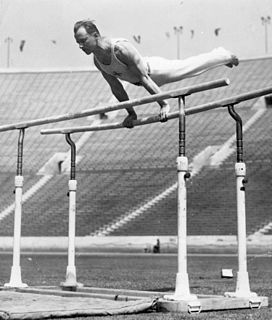
The men's parallel bars event was part of the gymnastics programme at the 1932 Summer Olympics. It was contested for the fifth time after 1896, 1904, 1924, and 1928. The competition was held on Friday, August 12, 1932. Fifteen gymnasts from six nations competed. Each nation was limited to three gymnasts. The event was won by Romeo Neri of Italy, the nation's first victory in the men's parallel bars. István Pelle earned Hungary's first medal in the event with his silver, while Heikki Savolainen similarly earned Finland's first medal with his bronze.

The men's parallel bars competition was one of eight events for male competitors in artistic gymnastics at the 2000 Summer Olympics in Sydney. The qualification and final rounds took place on September 16 and 25 at the Sydney Super Dome. There were 81 competitors from 30 nations; nations competing in the team event could have up to 5 gymnasts in the vault, while other nations could have up to 2 gymnasts. The event was won by Li Xiaopeng of China, the nation's first victory in the parallel bars. Lee Joo-Hyung earned South Korea's first medal in the event with his silver. Russia also received its first medal since the dissolution of the Soviet Union, with Alexei Nemov's bronze.
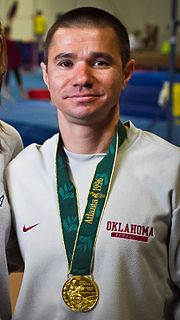
The men's parallel bars competition was one of eight events for male competitors in artistic gymnastics at the 1996 Summer Olympics in Atlanta. The qualification and final rounds took place on July 20, 22 and 29th at the Georgia Dome. There were 106 competitors from 31 nations, with nations in the team event having up to 7 gymnasts and other nations having up to 3 gymnasts. The event was won by Rustam Sharipov of Ukraine, the nation's first victory in the men's parallel bars after the dissolution of the Soviet Union. Jair Lynch earned the United States' first medal in the event since 1984 with his silver. Defending champion Vitaly Scherbo earned bronze for Belarus. He was the sixth man to win multiple medals in the parallel bars.

The men's parallel bars competition was one of eight events for male competitors in artistic gymnastics at the 1972 Summer Olympics in Munich. The qualification and final rounds took place on August 27, 29 and September 1 at the Olympiahalle. There were 112 competitors from 26 nations ; nations entering the team event had 6 gymnasts while other nations could have up to 3 gymnasts. Japan reached the height of its success in the event this year: putting four men into the six-man final and sweeping the medals. Sawao Kato earned Japan's third consecutive gold medal in the parallel bars, tying Switzerland for most golds all-time; Kato would break that tie in 1976 with his second gold medal. Shigeru Kasamatsu took silver while Eizo Kenmotsu earned bronze.

The men's parallel bars competition was one of eight events for male competitors in artistic gymnastics at the 1976 Summer Olympics in Montreal. The qualification and final rounds took place on July 18, 20, and 23rd at the Montreal Forum. There were 90 competitors from 20 nations, with nations competing in the team event having 6 gymnasts while other nations could have up to 3 gymnasts. The event was won by Sawao Katō of Japan, the first man to successfully defend an Olympic title in the parallel bars—and, as of the 2016 Games, still the only one to do so. It was the fourth consecutive victory by a Japanese gymnast in the event, breaking a tie with Switzerland for most all-time. Japan was unable to repeat its 1972 medal sweep, as nations were now limited to two finalists each. Nikolai Andrianov of the Soviet Union took silver, while Mitsuo Tsukahara of Japan earned bronze, missing a 1–2 finish for Japan by .025 points.
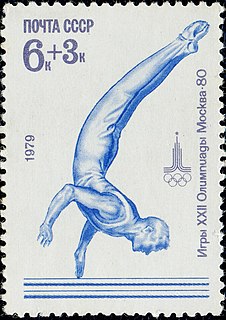
The men's parallel bars competition was one of eight events for male competitors in artistic gymnastics at the 1980 Summer Olympics in Moscow. The qualification and final rounds took place on July 20, 22 and 25th at the Luzhniki Palace of Sports. There were 65 competitors from 14 nations, with nations competing in the team event having 6 gymnasts while other nations could have to up to 3 gymnasts. The event was won by Aleksandr Tkachyov of the Soviet Union, the nation's first victory in the parallel bars since 1960 and third overall, tying Switzerland for second-most all-time behind Japan's four. Fellow Soviet Alexander Dityatin took silver, while Roland Brückner earned East Germany's first medal in the event. Japan's four-Games gold medal streak in the event ended with no Japanese gymnasts competing due to the American-led boycott.

The men's parallel bars competition was one of eight events for male competitors in artistic gymnastics at the 1968 Summer Olympics in Mexico City. There were 117 competitors from 28 nations, with nations in the team competition having up to 6 gymnasts and other nations entering up to 3 gymnasts. The event was won by Akinori Nakayama of Japan, the nation's second consecutive victory in the parallel bars event, tying Germany and the Soviet Union for second-most all-time behind Switzerland at three gold medals. It was the second of four straight Games that the parallel bars would be won by a Japanese gymnast. Mikhail Voronin took silver and Viktor Klimenko took bronze to put the Soviet Union back on the podium after a one-Games absence.

The men's horizontal bar competition was one of eight events for male competitors in artistic gymnastics at the 1960 Summer Olympics in Rome. It was held on 5, 7, and 10 September at the Baths of Caracalla. There were 130 competitors from 28 nations, with nations in the team competition having up to 6 gymnasts and other nations entering up to 2 gymnasts. The event was won by Takashi Ono of Japan, the nation's second consecutive victory in the men's parallel bars. Masao Takemoto gave Japan a second medal with his silver. Ono and Takemoto were the third and fourth men to win multiple medals in the parallel bars; Ono was the first to win two gold medals in the event. Boris Shakhlin of the Soviet Union took bronze.

The men's parallel bars competition was one of eight events for male competitors in artistic gymnastics at the 1960 Summer Olympics in Rome. It was held on 5, 7, and 10 September at the Baths of Caracalla. There were 129 competitors from 28 nations, with nations in the team competition having up to 6 gymnasts and other nations entering up to 2 gymnasts. The event was won by Boris Shakhlin of the Soviet Union, the nation's second consecutive victory in the men's parallel bars. Giovanni Carminucci earned Italy's first medal in the event since 1932 with his silver. Takashi Ono of Japan took bronze for a second consecutive Games, making him the fourth man to win multiple medals in the event.

The men's parallel bars competition was one of eight events for male competitors in artistic gymnastics at the 1956 Summer Olympics in Melbourne. It was held from 3 to 7 December at the Melbourne Festival Hall. There were 63 competitors from 18 nations, with nations in the team competition having up to 6 gymnasts and other nations entering up to 3 gymnasts. The event was won by Viktor Chukarin of the Soviet Union, the nation's first victory in the parallel bars. Japan took three medals: a silver by Masumi Kubota and bronzes by Takashi Ono and Masao Takemoto. It was the third time a nation had won three medals in the event in the same Games: the United States had swept the medals in 1904 and Switzerland had earned a gold and two bronzes in 1948. Chukarin was the third man to win multiple medals in the parallel bars; Ono would become the fourth in 1960.

The men's parallel bars competition at the 2012 Summer Olympics in London, United Kingdom was held at the North Greenwich Arena 1 on 28 July and 7 August. There were 71 competitors from 33 nations. The event was won by Feng Zhe of China, the nation's second consecutive victory in the parallel bars and third overall. Marcel Nguyen's silver was the first medal for united Germany in the event since 1936 and the first for any German gymnast in the parallel bars since 1988. Hamilton Sabot earned France's first parallel bars medal with his bronze.
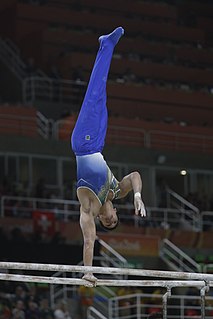
The men's parallel bars competition at the 2016 Summer Olympics was held at the HSBC Arena on 16 August. There were 67 competitors from 33 nations. The event was won by Oleg Verniaiev of Ukraine, the nation's first victory in the parallel bars since 2004 and third overall. Danell Leyva won the United States' first medal in the event since 1996 with his silver; David Belyavskiy's bronze was Russia's first medal in the parallel bars since 2000. China's four-Games podium streak in the event ended.

The vault is an artistic gymnastics event held at the Summer Olympics. The event was first held for men at the first modern Olympics in 1896. It was held again in 1904, but not in 1900, 1908, 1912, or 1920 when no apparatus events were awarded medals. The vault was one of the components of the men's artistic individual all-around in 1900, however. The men's vault returned as a medal event in 1924 and has been held every Games since. Vault scores were included in the individual all-around for 1924 and 1928, with no separate apparatus final. In 1932, the vault was entirely separate from the all-around. From 1936 to 1956, there were again no separate apparatus finals with the vault scores used in the all-around. The women's vault was added in 1952 and has been held every Games since. Beginning in 1960, there were separate apparatus finals.

The pommel horse is an artistic gymnastics event held at the Summer Olympics. The event was first held for men at the first modern Olympics in 1896. It was held again in 1904, but not in 1900, 1908, 1912, or 1920 when no apparatus events were awarded medals. The pommel horse was one of the components of the men's artistic individual all-around in 1900, however. The men's pommel horse returned as a medal event in 1924 and has been held every Games since. Pommel horse scores were included in the individual all-around for 1924 and 1928, with no separate apparatus final. In 1932, the pommel horse was entirely separate from the all-around. From 1936 to 1956, there were again no separate apparatus finals with the pommel horse scores used in the all-around. Beginning in 1960, there were separate apparatus finals.
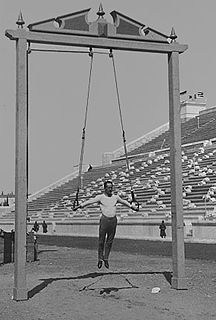
The rings is an artistic gymnastics event held at the Summer Olympics. The event was first held for men at the first modern Olympics in 1896. It was held again in 1904, but not in 1900, 1908, 1912, or 1920 when no apparatus events were awarded medals. The rings was one of the components of the men's artistic individual all-around in 1900, 1908, and 1912, however. The men's rings returned as a medal event in 1924 and has been held every Games since. Rings scores were included in the individual all-around for 1924 and 1928, with no separate apparatus final. In 1932, the rings was entirely separate from the all-around. From 1936 to 1956, there were again no separate apparatus finals with the rings scores used in the all-around. Beginning in 1960, there were separate apparatus finals.

The horizontal bar is an artistic gymnastics event held at the Summer Olympics. The event was first held for men at the first modern Olympics in 1896. It was held again in 1904, but not in 1900, 1908, 1912, or 1920 when no apparatus events were awarded medals. The horizontal bar was one of the components of the men's artistic individual all-around in 1900, 1908, and 1912, however. The men's horizontal bar returned as a medal event in 1924 and has been held every Games since. Horizontal bar scores were included in the individual all-around for 1924 and 1928, with no separate apparatus final. In 1932, the horizontal bar was entirely separate from the all-around. From 1936 to 1956, there were again no separate apparatus finals with the horizontal bar scores used in the all-around. Beginning in 1960, there were separate apparatus finals.






















